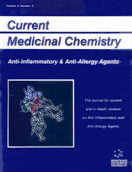Abstract
Endocannabinoids are amides, esters and ethers of long chain polyunsaturated fatty acids, which include anandamide (N-arachidonoylethanolamine, AEA) and 2-arachidonoylglycerol (2-AG) as the main endogenous agonists of cannabinoid (CB) receptors. The biological actions of these compounds at CB receptors depend on their life span in the extracellular space, which for AEA is regulated by intracellular uptake through a selective AEA membrane transporter (AMT), followed by intracellular degradation by an AEA-degrading enzyme (fatty acid amide hydrolase, FAAH). Together with AEA and 2-AG and their synthetic enzymes, CB receptors, AMT and FAAH form the “endocannabinoid system”. Here, we review recent literature on the properties of the constituents of this system, and on its role in inflammation. We also show how restraining the flexibility of the acyl chain of AEA affects the ability of this compound to bind to CB receptors and to interact with AMT and FAAH. Furthermore, we show how molecular dynamics simulations with free and restrained AEA and a number of its analogs, generated by lipoxygenase-mediated hydroperoxidation, help to understand the structural requirements essential for the interaction with the proteins of the endocannabinoid system. The hydroxy AEAs described herein might act in vivo as inhibitors of endocannabinoid metabolism, the only ones of natural origin as yet known. The relevance of these findings, which help to predict and facilitate the design of novel drugs with greater potency and / or selectivity at the different molecular targets of AEA, will be discussed in the light of their therapeutic potential.
Keywords: Endocannabinoid Degradation, Th erapeutic Agents, OXIDATIVE METABOLISM
 8
8

